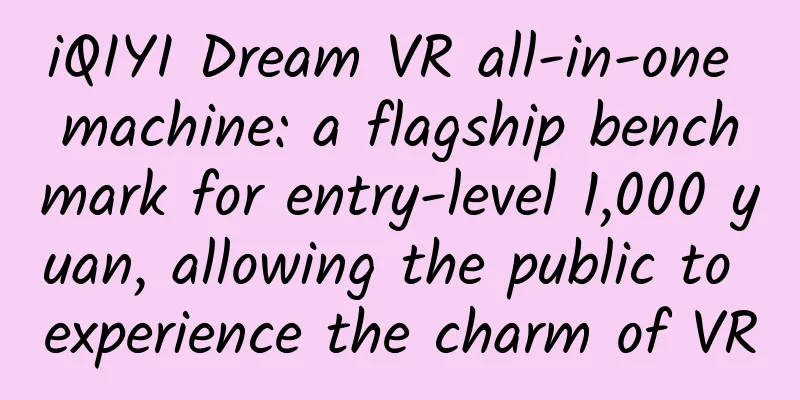iQIYI Dream VR all-in-one machine: a flagship benchmark for entry-level 1,000 yuan, allowing the public to experience the charm of VR

|
When is the first year of VR? When will the VR market explode? When will the VR experience be considered mature? These three questions have been around since the concept of VR began to emerge. It has to be admitted that VR has not yet shown a very convincing performance in the field of mass consumption. There are three main reasons for this. First, the price. Steam's own HTC Vive generally costs more than 3,000 RMB, and the most expensive package even exceeds 10,000 RMB. Facebook (Meta)'s Oculus Quest and Sony's PS VR both cost around 2,500 RMB, but accessories such as controllers need to be purchased separately, which is also expensive. The second problem is flexibility. Most VR products need to be connected to a computer or console to use. No matter how many people have game consoles or high-end computers, the restraint of the wire alone will reduce the experience of using VR products: the biggest charm of VR lies in the sense of immersion. It is common for the body to move involuntarily when using it. If you are restrained by the wire at this time, how can you feel immersed? Finally, there is the shortcoming of the content ecosystem. In the consumer market, the main use of VR is gaming, but the VR game development ecosystem has never been established. Among the major companies, only Valve has launched Half-Life: Alyx, and excellent works from small and medium-sized developers are even rarer. If you want VR products to quickly occupy the market, the three elements of easy-to-use products, interesting content, and low prices are indispensable. Among the many VR players at home and abroad, iQiyi, which has a unique advantage in content, is undoubtedly one that cannot be ignored. On December 1, iQIYI's subsidiary iQIYI Intelligence (now renamed "Dream Bloom") officially launched its new VR all-in-one device, Dream. As a 6DoF VR all-in-one device equipped with Qualcomm's XR2 flagship chip, Dream is priced at only 1,999 yuan, which is undoubtedly very attractive for users who want to try VR. Happiness is that simple From the appearance, Dream adopts a hat-like design, and the tightness can be adjusted through the knob on the back of the body. A forehead rest is installed above the headset to make the front and back weight of the entire machine more balanced, ergonomic, and you will not feel obvious fatigue even if you wear it for a long time. The reserved space inside the console is also quite sufficient, so myopic users can use it normally even when wearing glasses. Regardless of whether you wear glasses or not, Qiyu Dream can basically adjust the field of vision to the clearest state by simply adjusting the tightness after putting it on. It is simple and easy to use, and is also very friendly to first-time users. The controller of Qiyu Dream comes with the device, so you don't need to buy it separately. The control logic is similar to the Joy-Con of Switch. If you are worried about losing your grip due to excessive concentration, you can put on a wrist strap. You don't have to worry about not being able to find the key position after turning on the device. Just hold the controller in front of your eyes and the system will automatically display the purpose of each key. Qiyu Dream is a VR all-in-one device, which means it does not need to be connected to a mobile phone or computer and can work independently. After turning it on and wearing it, you can enter the magical world of virtual reality. I had never experienced VR equipment before, so my first reaction after putting on Dream was not that shocking. After all, I just saw a background that was completely different from usual, which was still within the scope of my imagination. But when I turned my head, I found that the Dream brought me not just a picture, but a whole new scene, which made me feel like I had entered another room instead of just looking at a screen. The room I usually live in is quite compact, but the Dream gave me the illusion that I was really living in a big house, and I even instinctively wanted to walk around. It was from this moment that I really realized how different VR is from ordinary games. Qiyu Dream uses Qualcomm's latest Snapdragon XR2 chip, which makes the entire system smooth, the picture clarity and the refresh rate reach a very high level, and there is no lag when using it. The handle plays a role similar to that of a mouse in operation, and there are rays to guide. In actual experience, the touch accuracy is also satisfactory. The QIYU OS 5.0 system on Qiyu Dream is developed based on Android 10, and its operating logic is very similar to that of mobile phones and other devices. For new users, as long as they are familiar with the operation of the handle, it is not too difficult to get started. For many users, the biggest dissuading factor of VR, besides the price, is the trouble of debugging. Even for users who are familiar with electronic products, it is inevitable that they will spend dozens of minutes or even an hour to connect VR equipment for the first time, which is a big blow to user enthusiasm. Qiyu Dream is truly ready to use, without the need for troublesome debugging or elaborate wiring. For users who want to get started with VR, this is a very suitable product. Entertainment is more than just games. When iQiyi first started working on VR, many people were surprised: iQiyi doesn’t make games, so why would they want to work on VR? In fact, this idea has invisibly narrowed the scope of VR applications, which is a pity. Think about the 3D movies that fill the cinemas. Who can say that film and television are not suitable for VR to show its strengths? Qiyu Dream has built-in iQUT Future Cinema 2.0, which synchronizes the video resources of iQiyi's entire network, including "Alita: Battle Angel", "White Snake 2: Rise of the Green Snake", "Fast and Furious 9", "Godzilla vs. Kong" and other theater blockbusters, and supports 3D stereo effects, HDR, AI image quality enhancement and other functions, bringing a different visual enjoyment. After opening the movie, the default playback mode is to simulate the scene of a movie theater. Looking around, coupled with the familiar opening sound effects and the dragon, it makes people nostalgic - when I think about it carefully, it seems that I haven't been to the cinema since the epidemic. If you don't like this cinema perspective, you can also choose the "eye tracking" mode, in which the movie screen will fill the entire headset and keep the screen in front of your eyes no matter how your head turns. Personally, I feel that this mode is very suitable for watching while lying in bed. After all, it is inevitable to hold up your phone or tablet with your hands, while using VR equipment allows you to lie flat completely, which brings us one step closer to the world of lying down and playing games in "Sword Art Online". Another benefit of watching movies with VR is that it can bring a 3D movie experience closer to the cinema. 3D movies in theaters often no longer have 3D effects when they are uploaded to the Internet. This regret cannot be made up for no matter how high-end the display equipment is. VR can bring the exclusive experience of the cinema to the home, realizing a true "home theater" effect. In addition to movies and TV shows, Dream also has panoramic video resources. We experienced the 8K panoramic video "Lake Baikal". As the name suggests, this is a film that allows viewers to appreciate the style of Lake Baikal. It uses panoramic VR shooting. Compared with 3D movies, this type of film is completely made for VR equipment and can better show the unique charm of VR. "Lake Baikal" has a strong sense of immersion, and it is full of surprises when looking around, especially the moment when I found that there were people traveling with me behind me. When watching it, I felt as if I was really riding a speedboat on Lake Baikal, and I couldn't help but think of the lyrics: "We lingered on the shore of Lake Baikal." In addition to video resources, iQIYI Qiyu VR has also begun to make significant efforts in the field of games. At present, 38 games have been launched on the Qiyu Dream App Store, and the first release will give away three games: "Ledong Future: Sound Project", "Professional Table Tennis VR" and "Crisis Action Team 2". Among them, "Music Future: Sound Project" is a rhythm game with a strong cyberpunk interface. The gameplay is very simple. After selecting a song, follow the rhythm, use the lightsaber in your hand to chop at the flying target, and avoid obstacles. Thanks to the 6DoF interactive technology on Dream, you can swing at more angles when playing. Relying on flagship configurations such as Snapdragon XR2, the game is very sensitive to motion capture, tracking and feedback. You should know that music games are basically the type that require the highest feedback speed among all games. In the process of experiencing "Music Future: Sound Plan", I did not feel any operational delay, which shows the powerful performance of Dream. At the same time, the vibration of the handle when hitting the target is just right, and the feedback is excellent. I also tried a shooting game called "Mercenaries: Smart Crisis". I have to say that I am still not used to VR games. After being beaten several times, I realized that in this kind of game, turning is not done by pulling the joystick, but by turning your head. The shooting and reloading of the game are also designed to be very immersive, especially the manual bolt after changing the magazine. This operation cannot be simulated by using either a keyboard, mouse or controller. If music games are about feedback speed, then shooting games are about feedback accuracy. From my experience in Mercenaries: Intelligence Crisis, I felt that Dream can hit whatever you point at, and when reloading, there will be no weird position judgment that will cause the bullet to be unable to be reloaded. Thanks to high-specification configurations such as the XR2 chip, 8G memory, and 6DoF interactive technology solutions, Dream can achieve fast positioning, stable tracking, and rapid feedback in all types of games, providing a more stable and smooth gaming experience. The future is opened by it It is obvious that Dream was launched to address the "three major problems" of the VR industry: price, flexibility, and resources. As a VR device, it adopts an integrated design and does not require any connection. You can play it while walking, standing or sitting in place, depending on your preference. In terms of content, Qiyu Dream has leveraged iQiyi's advantages in video resources and explored new usage scenarios for the product. For games, iQiyi has also adopted a boutique strategy to ensure that each game does not waste users' time. It is expected that by the end of next year, there will be 100 games online. As for the most critical price, Qiyu Dream is priced at 1,999 yuan, which is affordable for most consumers. On this basis, Qiyu Dream is also equipped with the top Snapdragon XR2 chip in VR devices - this is like a 1,999 mobile phone equipped with Snapdragon 888. The excellent performance also makes Qiyu Dream more cost-effective. For users who want to get started with VR, this is a benchmark product. Finally, back to the question at the beginning, when will VR explode? I'm afraid we still can't get a definite answer. But what is certain is that in order to achieve a complete explosion, VR must first allow consumers in the mass market to have the opportunity to access it. From this perspective, the emergence of flagship products such as iQiyi Qiyu Dream VR all-in-one machine, which costs only one thousand yuan, has undoubtedly brought this day one step closer. As a winner of Toutiao's Qingyun Plan and Baijiahao's Bai+ Plan, the 2019 Baidu Digital Author of the Year, the Baijiahao's Most Popular Author in the Technology Field, the 2019 Sogou Technology and Culture Author, and the 2021 Baijiahao Quarterly Influential Creator, he has won many awards, including the 2013 Sohu Best Industry Media Person, the 2015 China New Media Entrepreneurship Competition Beijing Third Place, the 2015 Guangmang Experience Award, the 2015 China New Media Entrepreneurship Competition Finals Third Place, and the 2018 Baidu Dynamic Annual Powerful Celebrity. |
<<: Alpha Egg AI Dictionary Pen X10: A personal tutor in a pencil case
Recommend
Understand Douyin e-commerce marketing methodology in one article
Chinese Internet companies generally do not set c...
This kind of "shrimp" is poisonous, and blue whales can swallow a whole group of them in one bite
Review expert: Li Weiyang, well-known popular sci...
The whale skeleton, which has been hanging for 24 years, has been leaking oil. How much oil does the whale have?
On March 1, 1998, a 5-year-old blue whale was acc...
15 essential data analysis methods for operations! !
When it comes to data analysis , people often thi...
Summary of content community product operation methodology
Content operation refers to the complete operatio...
Is hybridization the reason why the Qinghai-Tibet Plateau became the "cradle of evolution"?
Qinghai-Tibet Plateau Have a complex Geological t...
Kuaishou live broadcast promotion introduction and delivery guide
I heard that you work very hard when you are live...
How to write promotional ideas, write like this!
Why does my ad not have any traffic even though i...
Could a child really be trapped in a refrigerator? Can't the door be opened from the inside?
As a person from Northeast China, I know by heart...
Xiaomi and LeTV have not yet made a move. Can the existing micro-projection products replace traditional TVs?
In the technology circle, too many companies have...
How important is a perky butt to athletes? There are so many benefits to having a strong butt!
Ask a Question! What impressed you most about the...
How to improve new user retention rate?
I have been busy at work recently, so I reposted ...
Dark fermented food, nicknamed "public toilet", even foodies will tremble
Fermentation is a food processing method with a l...
How do offline stores build a user growth system?
With the development of the Internet, people are ...









